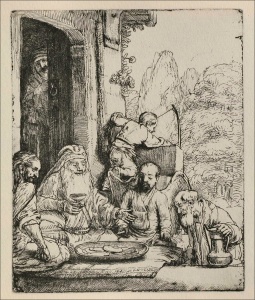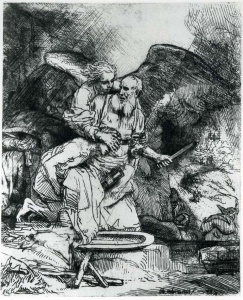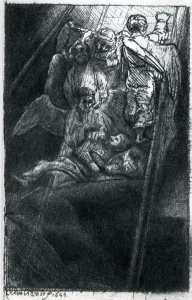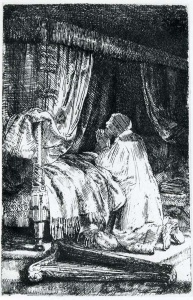Rembrandt Etchings
Walking out of the US Holocaust Memorial in Washington, D.C. the stench of mass murder was overpowering. Western Civilization, that hubristic culture celebrating man’s highest aspirations, seemed obscene. Stately government buildings that bespoke American power and beneficence only reminded me of American rejection of Jewish refugees before the war and refusal to bomb the rail lines during. America knew from the extensive newspaper coverage between 1934 to the end of the war of the Nazi murderous intent to annihilate the Jews. This alone made my beloved America an accessory to the crime. My country essentially did nothing. And what about God? Why did He hide His face?
Nearby in the National Gallery of Art glancing at masterpieces of Western art and remembering the beauty of Mozart and Beethoven, it seemed impossible that this was the same world. An American soldier liberating the camps remarked; “You can’t imagine…things like that don’t happen.” They did and still do.
The evil of the Holocaust is ultimately incomprehensible just as all evil is for all ages. It was so for Rembrandt, too. Three hundred and fifty years ago his age was marked by vicious civil war, invasions and, of course, the slaughter of Jews. Protestant and Catholic accused the Jews of deicide. The Chmielnicki massacres of 1648-49 murdered 100,000 Jews and destroyed 300 communities in the Ukraine. And yet for this Protestant artist in Amsterdam, neighbor and friend of many Jews, the Bible was key in the attempt to understand the human condition, evil and, most importantly, the nature of God.
A small exhibition at the National Gallery of Rembrandt’s etchings delineates his devotion to the Bible and presents five subjects he created between 1652 and 1656. With the Holocaust weighing on my mind his choice of subjects seems prescient. Abraham Entertaining the Angels, Abraham’s Sacrifice, Jacob’s Ladder and David in Prayer all had a connecting theme; God’s encounter with His created.

The first etching, Abraham Entertaining the Angels (1656) depicts a miracle unfolding; the aged couple Abraham and Sarah visited by three angels who would foretell Sarah’s pregnancy at the age of ninety. God tested his servants Abraham and Sarah withholding progeny until a ripe old age. Abraham in fact seems pushed aside, appearing only as a small figure in the lower right waiting to serve his seated celestial guests. These three strange beings; a powerful warrior intruding from the left margin, the center occupied by a gregarious and kindly old sage flanked by winged contemplative monk, dominate the image of Abraham’s hospitality. Abraham’s first son, Ishmael, son of Sarah’s maidservant Hagar, plays behind them shooting an arrow at an unseen quarry. Behind the guests the barren matriarch, Sarah, lurks inside the house just visible in the shadows and eavesdropping on the prophecy unfolding.
The old sage seems to be speaking as he gestures. Could it be he is telling Abraham that next year at this time Sarah will have a child? Could it be that this is the moment that Sarah laughs, doubting and incurring God’s anger. Could it be this is the moment she tests God?

The next image is the last and greatest test of the patriarch, the Abraham’s Sacrifice (1655). God’s command to Abraham to offer his son, Isaac, as a sacrifice evokes the horror, pain and confusion that the slaughter of millions summons in us. Surely an unfathomable test. Abraham passed the test spectacularly and had to be stopped by an angel. Rembrandt’s angel grasps both of Abraham’s arms, one holding the knife for slaughter, the other covering Isaacs face. This non-textual detail, the covering of Isaac’s face, is singularly found in all Rembrandt’s depictions and simultaneously bespeaks compassion for his child and the obliteration of his son’s personality. Isaac kneels submissively, not bound as the text stipulates, and appears more than ready to die. Abraham turns toward the angel annoyed and confused at being interrupted in doing God’s will. Questions immediately arise: why is Abraham annoyed and not overjoyed, where is the altar and where exactly is he standing, why is the scabbard provocatively hanging at this crouch, why does he cover his son’s face? Why did God demand such a test?

Jacob’s Ladder (1655) is the smallest and yet most intense of the etchings. Its dark brooding aspect goes well beyond Rembrandt’s normally dramatic lighting. Jacob is being gently awaken by two (or perhaps three) angels as one ascends (or descends) the famous ladder of the Biblical text. The entire lower third of the image is plunged into darkness, suggesting that Jacob is resting on a shadowy boulder that is perched above a chasm rendering the scene unstable and foundationless. Jacob seems to smile, happy to be awoken from one dream to be plunged into another. This revelation, the patriarch and the lower angels bathed in an indirect light, provokes a dark mystery. Jacob is leaving the surety of the Land of Israel to plunge into the uncertainty of exile, a cruel and conniving father-in-law, a complicated marriage with two sisters and finally a mighty struggle to return home. This episode is meant to reassure him and yet in Rembrandt’s etching darkness overwhelms the light, the ladder of ascent is not possible for Jacob and the heavenly glow will soon dissipate. God’s test for Jacob now is the very fabric of a complicated but enormously fruitful life.

Finally Rembrandt exposes us to everyday life with David in Prayer (1652). The scene is set in a typical Dutch bedroom; the canopy bed provides the stage for David’s jarringly Christian gesture of kneeling prayer before retiring. Jews never kneel in prayer and in fact stand as humble and proudly autonomous individuals to implore God. Nonetheless David kneels on a plush pillow as the details of the cover and the drapes that suggestively rest on the bedpost contrast with the simplicity of his nightshirt. David is enmeshed in physicality, his manuscripts at bedside and his famous harp casually resting on the floor. His flattened profile is concentrated on doing what most people are able to do, to pray, reaching out. The grand revelation of the patriarchs has become embedded in contemporary reality. God is sought but not necessarily found, at least not like in the previous narratives. God is distant and shockingly familiar in David’s Prayer. He seems silent now, even as He continues His tests.